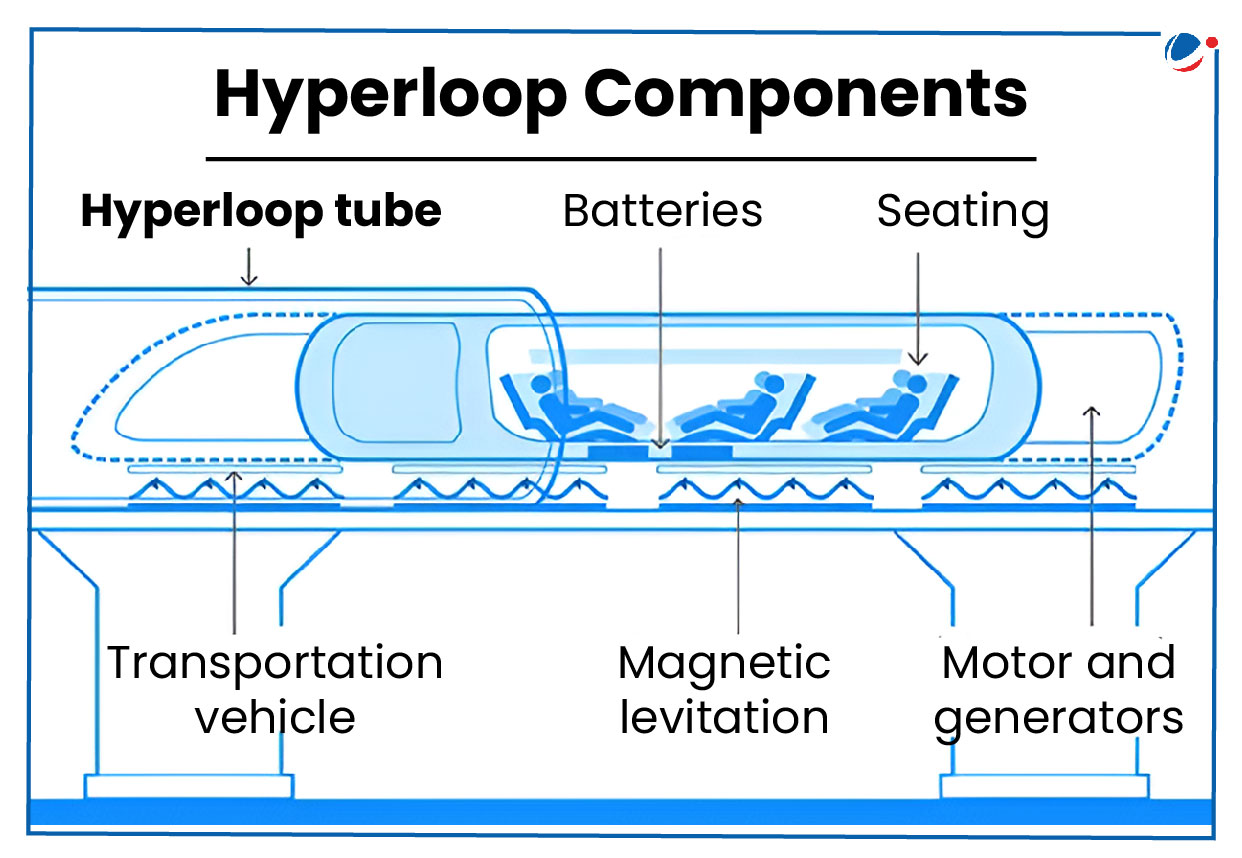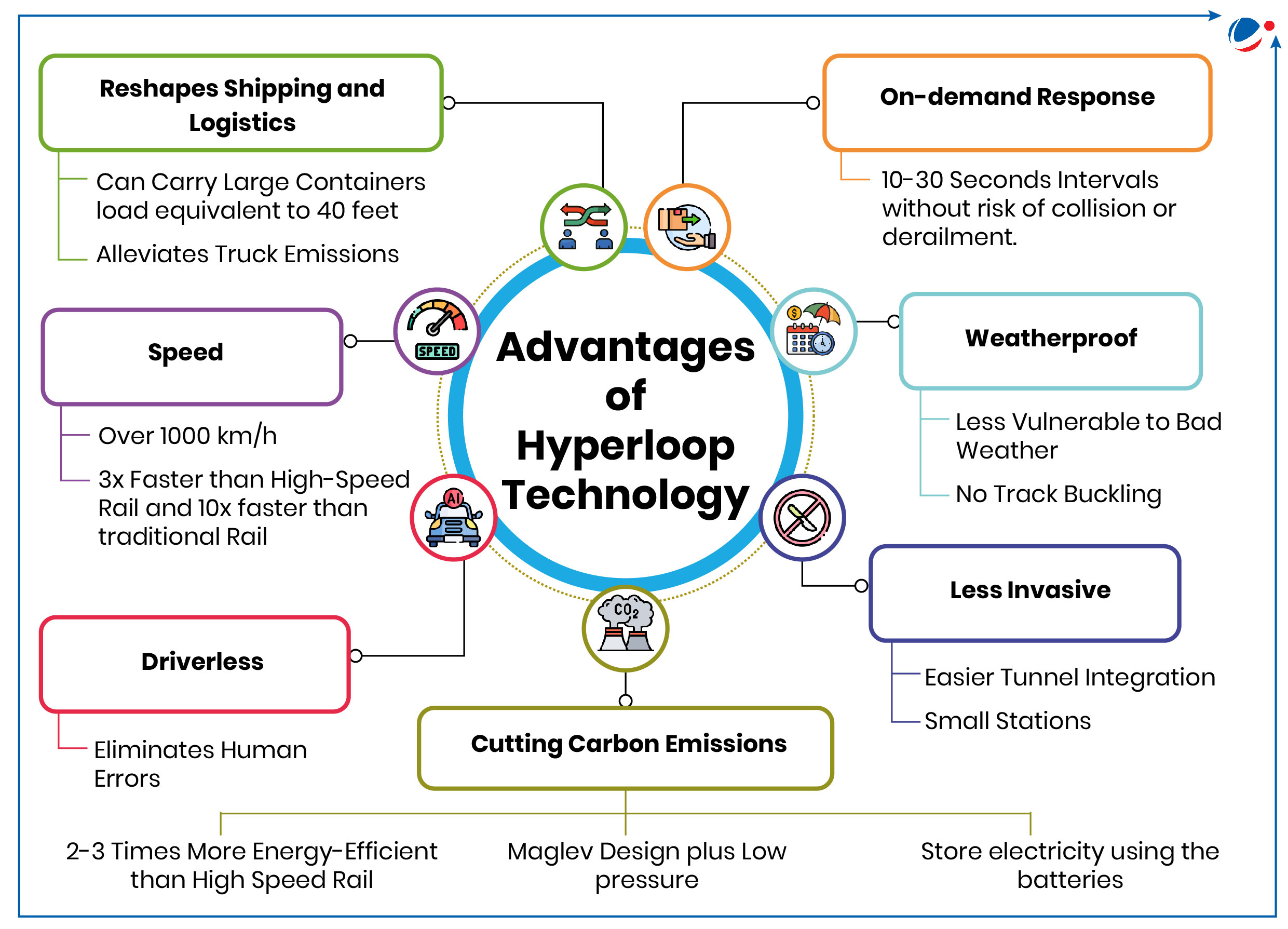Why in the News?
Avishkar Hyperloop team of IIT Madras in collaboration with TuTr (an startup) has recently completed a 410-meter Hyperloop test track, the first such experiment in Hyperloop technology in India.

What is Hyperloop Technology?
- Concept: In 2013, the CEO of SpaceX, Elon Musk, proposed a concept of ultra-high-speed rail (UHSR) called hyperloop and open-sourced it.
- Hyperloop: It is a high-speed transportation system in which pods, essentially pressurized vehicles travel at extraordinary speeds through low-pressure tubes.
- The technology significantly builds on a much older idea variously known as "gravity vacuum tube," "gravity vacuum transit," or "high-speed tube transportation," which dates originally back to 1865.
- Functioning:
- Hyperloop is essentially a magnetic levitation (maglev) train system that uses one set of magnets to repel cars so that they hover above a track and another set of magnets to propel them forward over the track.
- The track in hyperloop technology is a low-pressure tube with built-in vacuums that remove nearly all air from the steel tube.
- This concept enables the theoretical speed of 1,200 km/h.
- Accessibility: The technology has an ambitious goal to result in a time-space shrinkage, which will increase the accessibility of cities through very low travel times over long distances.
Components of Hyperloop
- Tube: Two steel tubes are welded together to allow the capsules travel in both directions. The expected air pressure inside the tube will be maintained around 100Pa.
- Capsule: The capsule has the capacity of carrying passengers. Magnetic linear accelerators are used to accelerate the capsules.
- Compressor: It is at front side of the capsule and allows the capsule to traverse through low pressure tube without choking the air flow that travels between tube walls and capsule.
- Suspension: For the purpose reliability and safety, the air bearing suspensions are used.
- Propulsion: To accelerate and decelerate the capsule linear induction motor is used over permanent magnet motor, as it lowers the material cost, reduces the weight of the capsule.

Some of the issues with Hyperloop technology
- Costs: A report into the commercial feasibility of hyperloop by NASA shared a cost of $25 – $27 million per mile for just the technology, excluding land acquisition.
- Hyperloop Safety: safety concerns such as fire, communication system challenges in capsule etc.
- While the low-pressure environment prevents fire from breaking out in the tubes, a fire inside a pod is a real threat.
- Evacuating a hyperloop is difficult as the tubes are designed to have a limited number of exits.
- Vacuum Maintenance Challenges: Maintaining an air vacuum in a tube for hundreds of kilometers is quite difficult and it takes a lot of energy to depressurize the tube.
- Huge acceleration impact: Any accelerations greater than about 2 m/s^2 in the lateral or vertical directions poses a difficulty for humans resulting in nausea and vomiting.
- Current hyperloop acceleration specifications are seven times greater than the maximum accelerations allowed for Japan's Shinkansen bullet train system.
- Need of straight line layout: It requires building stable and well-constructed elevated and/or tunnel-like structures over very long distances to maintain high speed and avoid any mishap.
Other Emerging Modern Transit Systems
|
Way Forward
- Substantial financial backing from private companies and governments: Financial backing is necessary for the research and development to find solutions such as depressurizing tubes efficiently.
- The Hyperloop Technology market size was valued at USD 2.05 billion in 2023 and is projected to reach USD 24.85 billion, with a CAGR of 36.6% by 2031.
- Continued Research and Development: Particularly in areas like Linear Induction Motors (LIM) for efficient propulsion.
- Infrastructure: Not only pod infrastructure but need for Hyperloop stations and infrastructure, which will require a number of projects, and should be added to the network of roads, railroad systems, and aviation.
- Need for regulations for standards and safety: India can frame policy on the line of European countries which came together and agreed to create a joint technical committee (JTC) called JTC 20 regarding Hyperloop in 2020.



